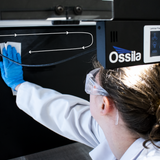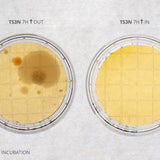How to Use a Laminar Flow Hood

Our laminar flow hood has everything you need to create a decontaminated workspace, including a compatible HEPA filter and inbuilt UV light. In order to keep your working environment clean, it is important to follow the correct procedures. Through these easy steps, you can prevent contamination and maintain a clean workspace.
This guide contains all our advice about using laminar flow hoods (for microbiological applications). However, the most important things to remember are contained in our golden rules.
Laminar Flow Hood Golden Rules
- Clean the hood with disinfectant before you use it.
- Organize your workspace to avoid cross contamination.
- Follow the correct working procedures to reduce the risk of contamination while working in the hood.
- If you think the workspace might be contaminated, clean the hood again. Remember, it is not worth undermining your experiment just to save time.
Keeping Your Workspace Clean
This is one of the most important factors to consider when working within a laminar flow hood. Firstly, it is important to make sure your laminar flow hood is clean before any materials enter it. It is just as important that the laminar flow hood remains clean throughout your experiment, especially for microbiological or molecular biological applications.
Cleaning the Hood Before Use
Clean inside and outside the laminar flow hood regularly. Once a week, clean the surface area below and around the hood with a combination of 70% ethanol and a surface disinfectant. This helps maintain a contaminant-free environment.

Avoid relying solely on the UV light for cleaning. It is important to wipe down exposed surfaces as well. A 70% ethanol/water solution is appropriate for before and after each use.
During cleaning, avoid touching or getting substances on the filter. This can damage the filter, reducing its effectiveness.
Running the hood
Ossil laminar flow hoods have inbuilt particle counters, giving you live information about internal particle concentration. You can see when the environment is clean enough to use.
It is common practice to run a laminar flow hood for at least 30 minutes before use. With our smart air sensing technology, we recommend running the hood for 20 minutes to allow the internal environment to stabilize.
Organizing your workspace
Do not overcrowd your working area as it can disrupt the air flow, rendering it less effective. Arrange your materials and equipment to reduce redirection of air flow as much as possible. Your set-up should facilitate minimal, slow movements while using the workspace.
Organize your equipment, waste containers, and reagent bottles to avoid placing used items near clean ones. It is crucial to avoid passing used items over clean items, especially in a vertical laminar flow hood. The waste receptacle should be placed on the side most convenient to you and away from other sterile materials. It should be tall enough to reduce the chances of cross contamination, and contaminated material should not be left in the laminar flow hood for long.
If using a vertical laminar flow hood, do not position yourself or your hands directly above sensitive samples. The downwards air flow can push contamination onto your samples.
If you are working in a horizontal laminar flow hood, position your samples (or any materials that you wish to remain uncontaminated) towards the back of the flow hood. Do not place your hands or other potentially contaminated materials (waste, used clean room tisses, pipettes, etc) behind these sample. If you do, any contamination will follow the airflow over your samples, risking contamination.
Using a Laminar Flow Hood
The human body is a major source of contamination in the laboratory. While using a laminar flow hood provides protection, the cleanliness of the environment is only as good as your working procedures. There are some recommended guidelines to follow:
- Ensure that only one person is working inside the hood at a time.
- Before bringing any equipment into the hood, spray it with a decontaminant to prevent contamination in your workspace. Contamination during microbiological applications is your worst enemy.
- With any materials (e.g. reagents, consumables) if you suspect they are contaminated, throw them out and replace them.
- Always wear proper personal protective equipment (PPE), including a lab coat and gloves. You should change your gloves and other PPE immediately if you suspect they have become contaminated.
- Keep your head and shoulders outside of the workspace to reduce the risk of sample contamination.
- Do not work inside the hood when the UV light is switched on.
When using a laminar flow hood, following proper working procedures is crucial. The above guidelines can help decrease the risk of contamination and ensure a clean working environment.
Learn More
 Laminar Flow Hood Cleaning Procedure
Laminar Flow Hood Cleaning Procedure
Regular and thorough cleaning of your laminar flow hood allows you to reliably conduct your experiments without risk of contamination.
Read more... Contamination Control: How Ossila Laminar Flow Hoods Perform
Contamination Control: How Ossila Laminar Flow Hoods Perform
You can test if the cleanliness of the air flow using settle plates and the surfaces using contact plates. To check that our laminar flow hood is suitable for microbiological uses, we tested for air and surface contamination.
Read more...